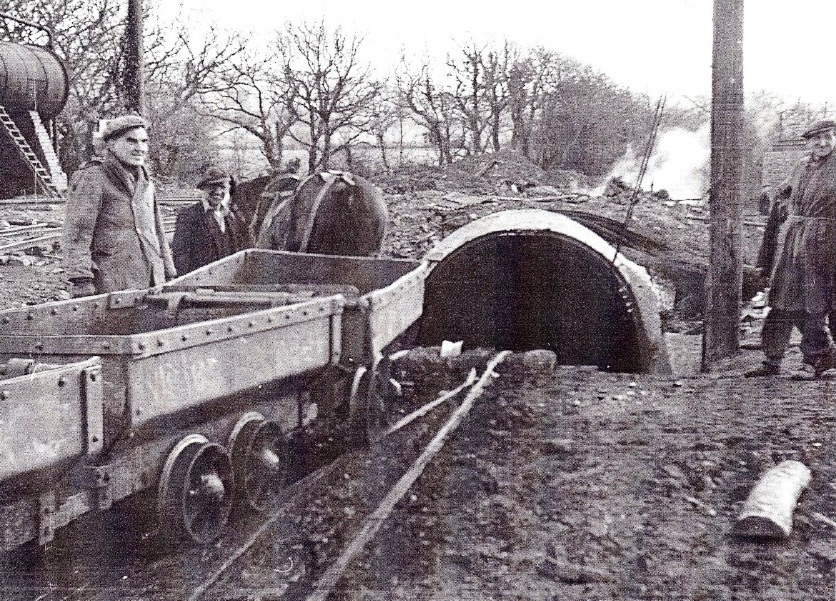 Pontyates, (46270662/New or Fforest Uchaf 46100715)
Pontyates, (46270662/New or Fforest Uchaf 46100715)
The Gwendraeth Valley marks the western outcrop of the main South Wales Coalfield, making Carway one of the most westerly slants in the Coalfield. It was one mile east of Cynheidre Nos. 1 & 2 shafts and one mile to the west of Trimsaran Colliery. In 1857 it was owned by the Carway Coal Company.
This anthracite slant was owned in 1863 by W.H. Yelverton who formed the Carway and Duffryn Coal Company Limited. It was managed in 1878 by S.O. Hands. In 1882/3 it was owned by the Wheal Gwendraeth Valley Company and was managed by William Edwards. In 1884/5 it was owned by T. Fenard and Company with David Rosser as the manager. Mr. Fenard became a bankrupt in 1888.
The Old Carway worked what it called the Big Vein extensively. This seam comprised of three layers of coal totalling nine feet thick. It also worked the Green Vein which was 38 yards below the Big Vein and was 40 inches thick. In 1896 a New Carway was owned by Joseph Birkenshaw of Derby who employed 6 men underground and 7 men on the surface. The manager was W.W. Walton.
In 1908 Carway was managed by William Lewis who was still manager in 1923. In 1901/7 it was owned by Carway Limited and employed 93 men, while in 1908 it was owned by Carway Collieries Limited and employed 113 men with Mr. Lewis still the manager. In 1927/30 it was T.E. Watkins. Carway Collieries by then was a Swansea-based company that did not join the Monmouthshire and South Wales Coal Owners Association. It was still owned by Carway Collieries in 1921, but by 1926 it was in the hands of United Anthracite Collieries Limited, and by 1932 with Amalgamated Anthracite Collieries Limited who, by 1934 employed 160 men underground and 60 men on the surface. This colliery by then had its own coal preparation plant and was managed by T.E. Watkins. The manager in 1943/5 was D.J. Evans. At that time it employed 166 men underground working the Big and Ddugaled seams and 71 men working at the surface of the mine.
Just a few of the fatalities at this mine.
- On the 26th of May 1944 an “outburst” at this colliery killed two miners.
- On the 11th of November, John Davies aged 21 years and a collier died under a roof fall.
- Just a few weeks later, Owen Davies, aged 21 years and also a collier also died under a roof fall.
- On the 23rd of October 1871, Thomas Davies aged 42 years and a collier, died under a roof fall.
- On the 25th of January 1872, J. Thomas aged 25 years and a collier was run over and killed by trams.
- John Jenkins was only 12 years of age and a collier when he died under a roof fall on the 21st of August 1872.
- On the 26th of May 1880, William Bowen aged 20 years and a trammer died when he was crushed by trams.
Along with the Nation’s other coal mines, Carway was Nationalised in 1947 and was placed in the National Coal Board’s South Western Division’s No.1 (Swansea) Area, Group No.1 (Pontyberem). At that time it employed 73 men on the surface and 258 men underground working the Big and Ddugaled seams. The manager was D.H. Rees. By 1954 Carway had pulled out of the Big Vein and was working both the Ddugaled and Felen seams employing 40 men on the surface and 213 men underground. The manager was now D.J. Evans. In 1955 out of the total colliery Manpower:of 237 men, 103 of them worked at the coalfaces, the coalface figure increased to 121 men in 1926 but dropped to 90 men on the coalfaces in 1958. It was closed by the National Coal Board on the 1st of July 1960 due to the exhaustion of reserves
Some Statistics:
- 1901: Manpower: 24.
- 1902: Manpower: 25.
- 1903: Manpower: 27.
- 1905: Manpower: 30.
- 1907: Manpower: 75.
- 1908: Manpower: 240.
- 1909: Manpower: 93.
- 1910: Manpower: 185.
- 1912: Manpower: 191.
- 1913: Manpower: 200.
- 1915: Manpower: 160.
- 1916: Manpower: 160.
- 1918: Manpower: 157.
- 1919: Manpower: 160.
- 1920: Manpower: 176.
- 1922: Manpower: 185.
- 1923: Manpower: 210.
- 1924: Manpower: 227.
- 1925: Manpower: 220.
- 1926: Manpower: 244.
- 1927: Manpower: 257.
- 1928: Manpower: 259.
- 1929: Manpower: 259.
- 1930: Manpower: 220.
- 1931/3: Manpower: 300.
- 1935: Manpower: 220.
- 1937: Manpower: 224
- 1938: Manpower: 241
- 1943: Manpower: 237.
- 1945: Manpower: 237.
- 1947: Manpower: 331.
- 1948: Manpower: 316. Output: 50,000 tons.
- 1949: Manpower: 274. Output: 50,000 tons.
- 1950: Manpower: 234.
- 1953: Manpower: 231. Output: 45,000 tons
- 1954: Manpower: 253. Output: 34,096 tons.
- 1955: Manpower: 237. Output: 29,256 tons.
- 1956: Manpower: 255. Output: 44,332 tons.
- 1957: Manpower: 257. Output: 42,264 tons.
- 1958: Manpower: 239. Output: 41,113 tons.
- 1960: Output 8,782 tons.
Information supplied by Ray Lawrence and used here with his permission.
The plans below have been prepared by Lee Reynolds and used here with his permission.
Composite plan of all seams
Big Seam
Brasslyd Seam
Ddugaled Seam
Felen Seam

